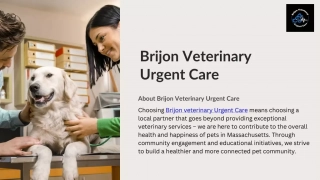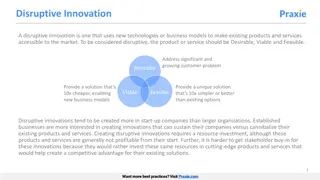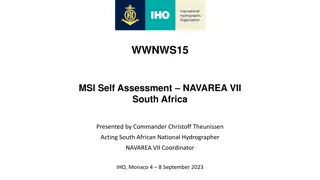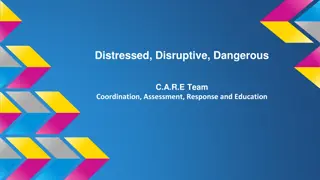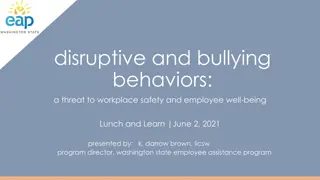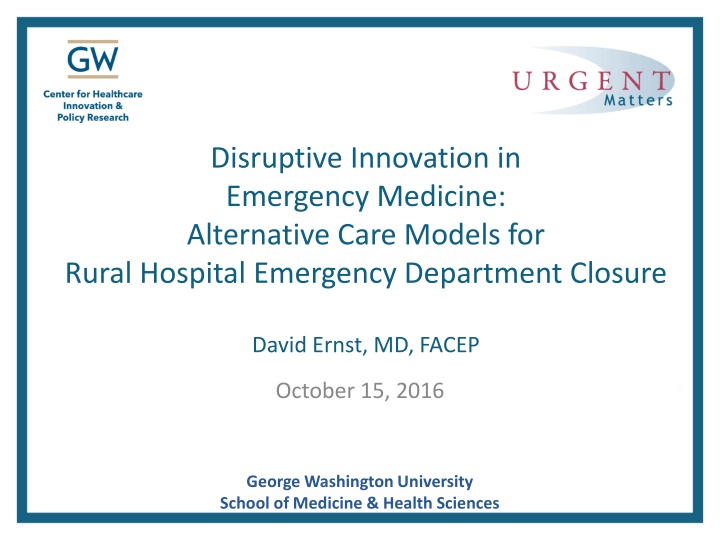
Innovative Care Models for Rural Emergency Medicine Challenges
Explore disruptive innovations in emergency medicine for rural hospital closures, including freestanding emergency centers, reimbursement options, and legislative changes. Learn about Urgent Matters and the critical statistics of rural and critical access hospitals in the US.
Download Presentation

Please find below an Image/Link to download the presentation.
The content on the website is provided AS IS for your information and personal use only. It may not be sold, licensed, or shared on other websites without obtaining consent from the author. If you encounter any issues during the download, it is possible that the publisher has removed the file from their server.
You are allowed to download the files provided on this website for personal or commercial use, subject to the condition that they are used lawfully. All files are the property of their respective owners.
The content on the website is provided AS IS for your information and personal use only. It may not be sold, licensed, or shared on other websites without obtaining consent from the author.
E N D
Presentation Transcript
Disruptive Innovation in Emergency Medicine: Alternative Care Models for Rural Hospital Emergency Department Closure David Ernst, MD, FACEP October 15, 2016 George Washington University School of Medicine & Health Sciences
Agenda 1. Overview of Current Rural and Critical Access Hospital Statistics 2. Discussion of Freestanding Emergency Center Utilization as Alternative for Emergency Care in Underserved Areas 3. Overview of Reimbursement Options, Legislation, and Licensing changes to Create Economically Viable Business Model in Rural Environments
About Urgent Matters Urgent Matters started in 2002 as a ten-hospital collaborative Learning Network that provided breakthrough research on patient flow measurement and improvement. The participating hospitals implemented rigorous performance measures, assessed current processes, and used techniques of rapid cycle change to improve ED throughput and output, ultimately finding that overcrowding can in large part be addressed through better capacity and patient flow management with a highly structured approach using mainly existing resources. Our second collaborative included six hospitals that worked together to identify, develop and implement strategies to improve patient flow and reducing ED crowding. Since, 2002, Urgent Matters has served as a virtual network of emergency care stakeholders, and has become an industry-important dissemination vehicle for innovative strategies on emergency department (ED) patient flow and quality. Urgent Matters acts as a central resource for hospital staff to discover field-tested initiatives that can be tailored to their organization. Our multidisciplinary audience is engaged through webinars, a searchable collection of ED improvement tools and strategies, an annual meeting, a podcast series and a blog. Discover more about Urgent Matters by visiting our website: www.urgentmatters.org
Rural and Critical Access Hospital Statistics 1. Of the 4,926 acute care Hospitals in the US, 2078 are Rural Hospitals with 1332 of those being Critical Access Hospitals (CAH).(1) 2. Over 480 Rural and Critical Access Hospitals have closed since 1990.(1) 74 have closed since 2010.(2) 3. 77% of the 2,050 rural counties in the US are designated Health Professional Shortage Areas (HPSA) by HHS.(1)
Rural and Critical Access Hospital Statistics 4. More than 50% of patients living in HPSA s travel more than 60 miles to receive Emergency Medical Care.(1) 5. Rural Hospitals in 39 states have been identified as vulnerable to closure and 38% of CAH (500 +) operate at an annual financial loss.(2,3) 6. In 2013 the HHS (OIG) recommended revised funding and closure of 70% of each state s CAH.(4)
Rural and Critical Access Hospital Statistics 7. Economic pressures from ICD-10 conversion, lack of Medicaid Expansion in many states, High Deductible Insurance Plans, lack of technical resources to obtain Meaningful Use EHR Incentives, and a transition to Quality Based Reimbursement (MACRA) by CMS are all contributing to the continued financial erosion of Rural and CAH Hospitals and accelerating closures.
Potential Solution: Freestanding Emergency Centers (FEC) as Replacement Care Models for Rural or CAH Hospital-Based Emergency Departments That Have Closed or Are at Risk
Fundamental Premises: 1. Emergency Departments are the care environments and Emergency Physicians are the care providers best suited for providing Emergency Medical Care. 2. Freestanding Emergency Centers (FEC) are 24 x 7, full service Emergency Departments, staffed by Physicians and Nurses trained in Emergency Medicine, and providing Quality and Efficient Emergency Medical Care.
Fundamental Premises: 3. The closure of Rural and CAH Hospitals leaves the surrounding community without access to Emergency Medical Care. Conclusion: Freestanding Emergency Centers may provide an equivalent quality, efficient, and cost effective care model for providing Emergency Medical Care in communities that have lost a hospital based Emergency Department.
Freestanding Emergency Centers (FEC) as Replacement Care Models for Rural Hospital Based EDs Challenges to FEC use in the Rural Environment: 1. Licensure Hospital license and distance requirements 2. Certificate of Need (CON) - 35 States Require 3. CMS Recognition for Facility Fee Reimbursement 4. Economic Viability Medicaid Expansion / Payer Mix 5. Lack of incentive for independent venture
Freestanding Emergency Centers as Replacement Care Models for Hospital Based EDs Potential Solutions: 1. Micro Hospital Hub and Spoke 2. Hybrid Model FEC and UC 3. Lobby States for CON change or exclusion for underserved areas 4. Allow independent licensure and no distance requirement 5. Medicaid Expansion / CMS recognition 6. Federal and/or State Stipend 7. Local or County Levy or Bond Issue Stipend
Freestanding Emergency Centers as Replacement Care Models for Hospital Based EDs Current Momentum for Change: 1. MedPAC June 2016 Recommendations to Congress(5): o Allow CAH closing to convert to FEC o Cost shift current CAH funds to Stipend FEC o Provide fixed Stipend or grant to cover standby costs o Recognize FEC for facility Fee (Part B) o Require Stipend from local community
Freestanding Emergency Centers as Replacement Care Models for Hospital Based EDs Current Momentum for Change (Cont.): 2. Senate Bill S.1648 - Rural Emergency Acute Care Hospital Act (REACH). o Sitting in Finance Committee since 2015 o Allow FEC to replace closing or closed CAH o Eliminate distance requirement o Reimburse at 110% of Cost
Freestanding Emergency Centers as Replacement Care Models for Hospital Based EDs Current Momentum for Change (Cont.): 3. Georgia Initiative 2014 Gov. Nathan Deal o License rules changed to allow FEC to replace closed CAH in rural area o No FEC resulted due to not expanding Medicaid to address Reimbursement and Stipend options to make economically viable 4. Illinois 2012 HB5142 Allows FEC with pop. < 50,000
Freestanding Emergency Centers as Replacement Care Models for Hospital Based EDs Current Momentum for Change (Cont.): 5. House Bill HR.3225 Save Rural Hospitals Act 2015 o License rules changed to allow Community Outpatient Hospital to replace closed CAH o Emergency Department with other Outpatient Services may be added on
Freestanding Emergency Centers as Replacement Care Models for Hospital Based EDs Current Examples: 1. Lennox Hill FEC - Manhattan NYC o 160 yr old St. Vincent s closes on West Side leaving large care void o Lennox Hill acquires CON and creates 1st NY FEC o Financially solvent upon opening July, 2014 o 40,000 annual volume o Within 6 mo. NYU opens FEC in Brooklyn
Freestanding Emergency Centers as Replacement Care Models for Hospital Based EDs Current Examples: 2. Texas o Urban saturation creating movement to Rural Areas o Sherman, Odessa, Midland, Wichita Falls 3. Tennessee o Current negotiations with Tx FEC Company to acquire closing CAH license and open FEC
Freestanding Emergency Centers as Replacement Care Models for Hospital Based EDs 4. North Carolina o Franklin Medical Center Louisburg, NC Closes o New legislation allows FEC in county with hospital in adjoining county and 3 Health Systems bidding 5. Arizona o Cochise Regional in Douglas closes 2015 o Copper Queen Hospital in Bizbee opening $5.5M FEC in Douglas under base hospital license
Freestanding Emergency Centers as Replacement Care Models for Hospital Based EDs Questions?
References 1. National Rural Health Association. About Rural Health. Website.Accessed at http://www.ruralhealthweb.org/go/left/about-rural-health/what-s-different- about-rural-health-care on April 15, 2016. iVantage Health Analytics. February 2016. 2016 Rural Relevance: Vulnerability to Value Study. Accessed at http://www.ivantagehealth.com/healthcare-research on April 20, 2016. American Hospital Association. The Fragile State of Critical Access Hospitals Infographic. Accessed at http://www.aha.org/advocacy-issues/cah on April 15, 2016. Office of Inspector General, Department of Health and Human Services. August 2013. Most Critical Access Hospitals Would Not Meet the Locations Requirements if Required to Re-enroll in Medicare. Accessed at http://oig.hhs.gov on May 3, 2016. Medicare Payment Advisory Commission. June 2016. Report to Congress: Medicare and the Health Care Delivery System. 7:203-225. Washington, DC: MedPAC. 2. 3. 4. 5.

